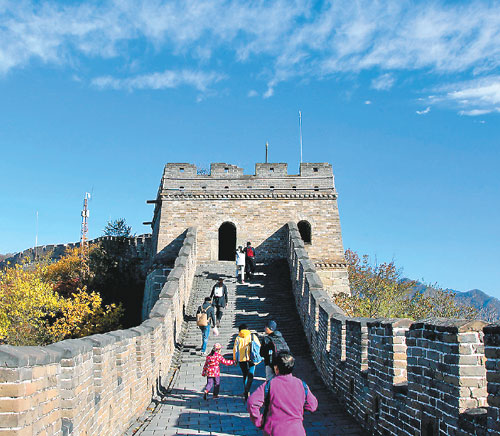 |
|
Visitors enjoy fresh air on a mainly blue-sky day during a trip to the Great Wall at Mutianyu outside Beijing in October. Pu Xiangdong / Xinhua |
BEIJING - Addressing lawmakers during a bi-monthly session of the National People's Congress (NPC) Standing Committee, environment minister Chen Jining said stricter enforcement of tough environmental laws was a key factor in curbing air pollution.
One year after the world's second-largest economy "declared war" on pollution after decades of pursuing growth at the expense of the environment, air pollution has become one of the top concerns for Chinese citizens, particularly those living in big, industrial cities in the central and eastern regions of the country.
According to an MEP communique released earlier this month, only 16 of the 161 major cities subject to air quality monitoring met the national standards for clean air in 2014.
China's overall air quality improved in 2014 and early this year
Average PM10 readings in 338 cities monitored by the MEP dropped by 2.1 percent year on year in 2014, and by 5.3 percent in the first four months of 2015.
Readings of PM2.5 -- smaller particulate matter which can penetrate deep into the lungs, thus posing a greater health threat than PM10 -- dropped in 74 cities by 11.1 percent in 2014 and 15.2 percent from January to April this year, the minister said.
Air quality changes were particularly evident in the notoriously smoggy Beijing-Tianjin-Hebei region, where PM2.5 readings recorded faster-than-average drops: 12.3 percent in 2014 and 20 percent this year, according to Chen.
Government financial support and enforcement essential
He attributed the decrease to additional government financial support and enforcement of its policies, new technology and better coordination between ministries and among cities in the Beijing-Tianjin-Hebei region, the Pearl River Delta and the Yangtze River Delta.
The government earmarked 9.8 billion yuan ($1.6 billion) for air pollution prevention and control in 2014 in addition to 2.5 billion in budget investment arrangements, Chen said, adding that government funds helped leverage private investment worth some 300 billion yuan.
He noted that China had managed to meet its target set in the 12th Five-Year Plan (2011-2015) to cut outdated capacity in the polluting steel, cement and glass sectors one year ahead of target, and that optimization of the country's energy structure is already in motion.
Usage of clean energy rises
Nationwide consumption of coal fell for the first time in 15 years in 2014, when it declined 2.9 percent. Clean energy sources such as hydroelectricity, wind energy, nuclear energy and natural gas, meanwhile saw their total share in the power mix rise by 1.3 points to 16.9 percent.
Discharges of key pollutants including sulphur dioxide, oxides of nitrogen (NOx) and volatile organic compounds (VOC) have been checked, whereas vehicle emissions have been curbed by pulling heavy-polluting vehicles off the road while promoting new energy automobiles.
8,500 arrested for environmental crimes in 2014
Chinese police arrested around 8,500 suspects in more than 4,500 environment-related criminal cases in 2014, as the country waged war against pollution, Chen said.
Environmental authorities transferred more than 2,000 cases of suspected environmental law violations to the police, more than double the figure for the past 10 years combined.
Close to 3,400 companies and 3,700 construction sites were also found to have violated environment laws and more than 3,100 workshops were closed following air quality inspections by Ministry of Environmental Protection (MEP) officials and drones, Chen said.
